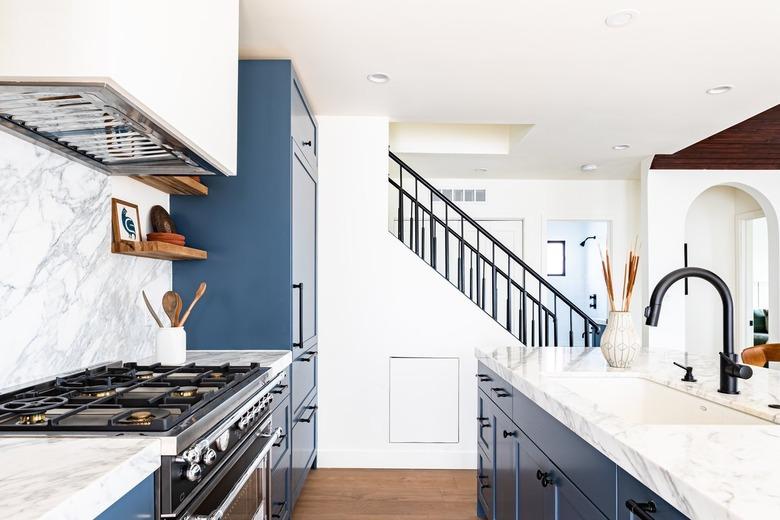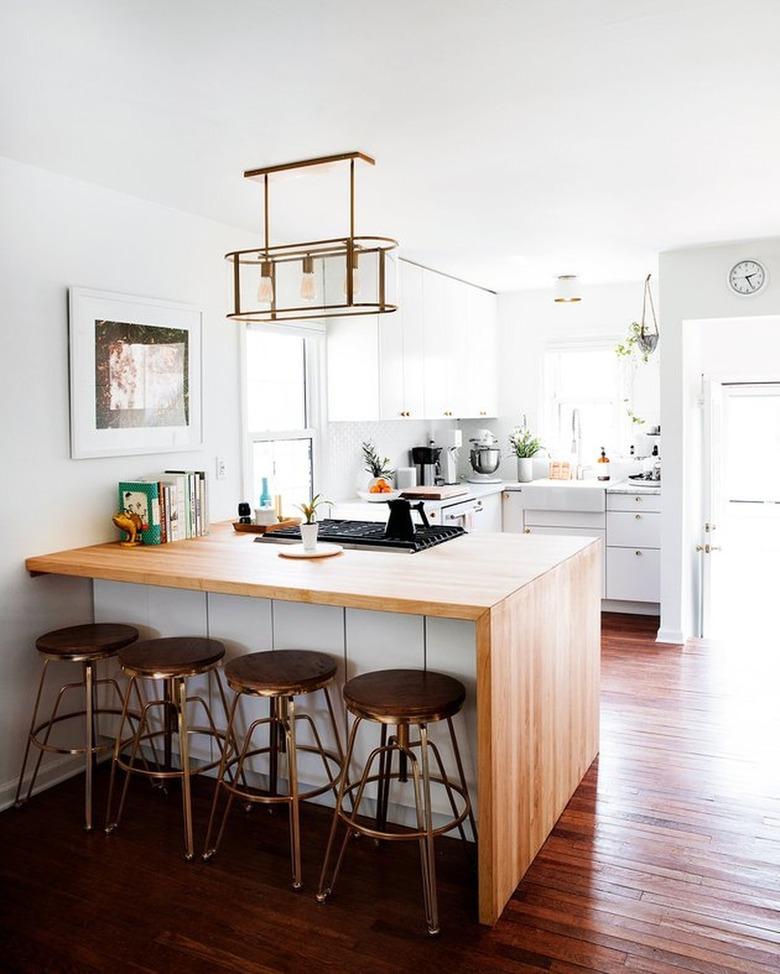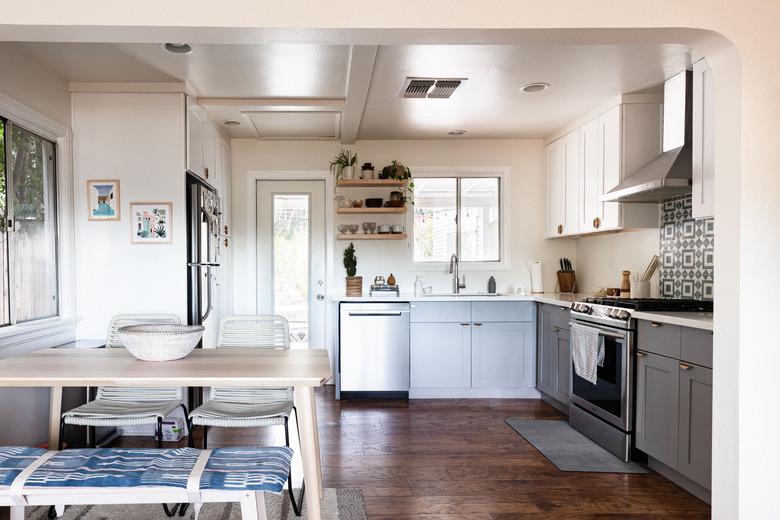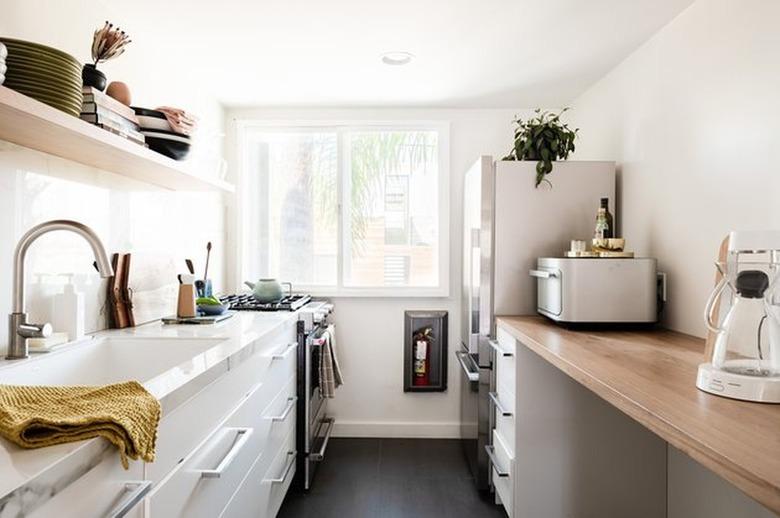DIY Kitchen Remodel: A Beginner's Guide
There's nothing quite like the look and feel of a brand new kitchen with upgraded appliances and fresh decor. And the good news is, you don't have to shell out big bucks for a full DIY kitchen remodel just to fix up the heart of your home. In fact, a few minor updates and a little elbow grease can help you DIY your way into a budget-friendly cook space that looks high-end. You might be surprised how different the entire kitchen looks when you do a simple refresh with new paint, cabinet doors, and appliances.
Assessing Your Needs and Wants
If you are planning on doing your own kitchen remodel and don't have a massive budget, you need to make a list of things that you realistically can afford to change. Once you figure this out, decide what home improvement tasks you can do without professional help. Maybe the torn up linoleum floor needs to go, but installing tile isn't in the scope of DIY projects you feel you can handle. In that case, perhaps you go with laminate flooring instead. Do you need more storage space but aren't up to the challenge of installing kitchen cabinets yourself? Then maybe adding more shelving and selecting some chic storage units are the solutions.
Keep in mind there are some things you probably can't and shouldn't DIY. For example, your wiring might need to be upgraded, so hiring an electrician is your best bet. You'll want to minimize the number of projects you have to hire out, but sometimes there's no way to avoid specialized work like plumbing and electrical. And let's face it, you want those things done right the first time. You can, however, make this work more affordable by doing some of the grunt work yourself. Try removing drywall or cabinets to provide access to plumbing or electrical lines.
Kitchen Remodel Costs and Budgeting
When starting a full kitchen remodel, experts recommend that your spend equal about 5% to 15% of your total home budget. In fact, the average cost of a kitchen is $24,173, but if you're planning to do it yourself and want to save money, this price may seem too high. Low-end kitchen remodel budgets for DIYers tend to start at $4,000, but you can make a handful of important changes for even less.
Figure out what you can realistically spend on a kitchen remodel without breaking the bank, and then deduct 20% of that number to set aside for unforeseen circumstances. After all, if a pipe breaks while you're working on the sink, you're going to need extra money available immediately for emergency plumbing services.
Once you decide on a maximum budget, look at your list of changes and start pricing items, focusing on the highest priority items first. Remember to always purchase products that are made to last without breaking the bank. Try to strike a balance between quality and aesthetic appeal, and focus more on your personal preference than trends that may go out of style.
Keep in mind that installing kitchen cabinets is not only difficult but also expensive. In fact, cabinets account for one of the biggest expenses. So unless you desperately need a new set, it's best to spruce up your existing cabinets by adding a fresh coat of paint, hardware, and trim, or by refacing them with wood veneer and replacing the drawers and doors.
Preparing for a Kitchen Remodel
One of the most important planning steps is finding out whether you need a permit for the project. Once you've determined all of the work that will be done, contact your city's building department to ask about permit requirements. For many kitchen makeovers, licensing is not required. But if you have to add electrical circuits or make plumbing changes, you will likely need permission.
Additionally, don't start working until you have all of your supplies and materials in hand. Clear out any cabinets, pack things up safely, and protect everything you're not working on by covering it with a drop cloth. If you're installing something like a dishwasher, doing any basic electrical or plumbing work yourself, replacing drywall, or working on anything that may put you dangerously close to live wires, be sure to turn off the water, electricity, or gas supplies during the process.
Steps to Completing Your DIY Kitchen Remodel
In a traditional kitchen remodel, it's best to complete the work in the following order: demolition, plumbing, electrical, drywall, paint, flooring, cabinetry, countertops, lighting, appliances, sink, backsplash, and hardware. When doing a DIY refresh, though, you'll want to skip ahead to the steps you'll actually do yourself, most likely starting with paint.
Paint the Walls
Start by cleaning your walls to ensure they are ready for a new layer of color. Next, cover the edges of all cabinets, ceilings, and floors with painters' tape. Fill in any holes with spackle; then sand down the edges as well as any areas where the old paint has bulged or cracked. Use roller brushes to cover the walls with a solid, slow, up-and-down motion. After that, use a small brush for the edges. Lastly, the Environmental Protection Agency recommends turning on fans to help drive any paint fumes outdoors for safety.
Laminate and engineered hardwood can often be installed on top of your existing floor if it is in good condition; otherwise, you will need to remove the original kitchen flooring first. Once you get rid of the top layer, prep your subfloor by cleaning, repairing, and smoothing it. Or install an underlayment, such as a cement board for tile.
Additionally, laminate and glazed ceramic tile are two of the most popular materials for kitchen floors since they look good and are typically resistant to water damage and stains. If you are using unglazed tile, hardwood, or other materials that are not naturally water-resistant, be sure to seal the flooring before moving on to the next step of your kitchen renovation.
Whether you're repainting or refacing the cabinets, start by removing the drawers and doors. You'll need to clean, repair, and sand just as you did when painting the walls. Then tape off the walls and counters to protect them. Next, apply a primer and remove the hardware from doors and drawers. Follow the primer with a layer of paint. When dry, reinstall the hardware and put the drawers and cabinets back in place.
To reface the cabinets, glue plywood on the exposed sides. Then use a utility knife to cut peel-and-stick veneer so it is two inches longer and half an inch nch wider than the front parts of the cabinet, working with the vertical lines, followed by the horizontal ones. Peel the back off of the veneer, and stick it to the cabinet using a wooden block to force air bubbles out from under the strip. With a utility knife, cut off the excess veneer. Repeat this process until the front is covered; then move on to the sides. Finally, install new cabinet doors and drawers that match the veneer.
Replacing countertops is expensive, but if you want a new look, you can always try repainting them. Rust-Oleum and other companies even sell paints specifically for counters. Start by taping off cabinets, walls, and sinks to protect them from this particularly hard-to-remove pigment, and clean your counters well. Wear gloves and use a ventilator. Finally, use a foam roller to apply a layer of paint, following up with a second layer the next day.
A new sink and faucet don't have to cost a fortune and can provide a lot of bang for your buck. This is a good place to spend a little money to update both the look and function of a kitchen. If you're not replacing the countertops, choose a new basin that installs like the original (drop-in, undermount, apron, etc.) and is similar in size. This will eliminate the need to modify your countertop for a new installation. Often, it's easiest to attach the faucet before installing the sink.
Peel-and-stick backsplashes are much easier to install and can be more affordable than traditional tile options. Simply clean your wall with an all-purpose cleaner; then use a pencil and ruler to measure your wall and mark where the tiles need to go. When you've finished planning the layout, just peel off a third of the backing, line it up, and stick it to the wall. Then, remove the rest of your backing and push the tile firmly to the wall. To cut pieces for the edges and fit around things like outlets, use a cutting mat and a box cutter.
Where to Shop:
References
- Quicken Loans: The Step-by-Step Guide to Remodeling Your Kitchen
- Cliq Studios: A Step-by-Step Kitchen Remodeling Timeline
- The Budget Decorator: DIY Budget Kitchen Makeovers – One Project at a Time
- Cliq Studios: How to Start a Kitchen Remodeling Project
- Home Remodeling Costs Guide: Kitchen Remodel Cost Breakdown – Recommended Budgets & More
- HomeAdvisor: How Much Does It Cost To Remodel A Kitchen?
- Food52: How to Successfully Paint Your Kitchen in One Day
- Ugly Duckling House: I Painted My Kitchen Countertops
- U.S. Environmental Protection Agency: Addressing Indoor Environmental Concerns During Remodeling










